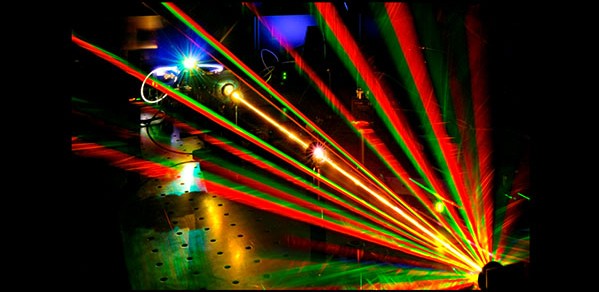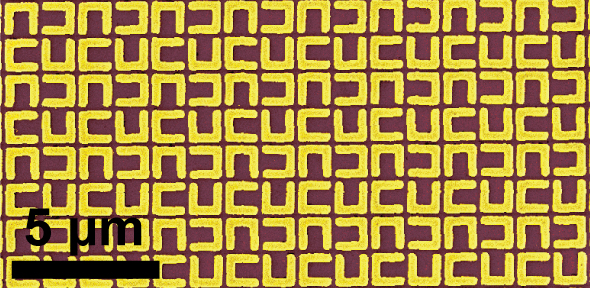
A new method to sensitively measure the structure of molecules has been demonstrated by twisting laser light and aiming it at miniscule gold gratings to separate out wavelengths.
The gold chiral nano-gratings, fabricated at the University of Cambridge, effectively 'twist' the light at optical frequencies and will allow us to enhance the molecular chiral signal by orders of magnitude to rapidly identify the 'handedness' of molecules.
Dr Calum Williams
The technique could potentially be used to probe the structure and purity of molecules in pharmaceuticals, agrochemicals, foods and other important products more easily and cheaply than existing methods.
Developed by physicists at the University of Bath, working with colleagues at the University of Cambridge and University College London, the technique relies on the curious fact that many biological and pharmaceutical molecules can be either ‘left-handed’ or ‘right-handed’. Although such molecules are built from exactly the same elements they can be arranged in mirror images of each other, and this configuration sometimes changes their properties drastically.
The research team from the Centre of Molecular Materials for Photonics and Electronics (CMMPE) at the University of Cambridge, was part of the collaborative team which used a special white-light laser system built in-house at the University of Bath, and directed it through several optical components to put a twist on the beam. The twisted laser beam then hits a nano-scopic U-shaped gold grating which serves as a template for the light, further twisting the beam in either a right or left-handed direction. This deflects the beam in many directions and further splits it into its constituent wavelengths across the colour spectrum.
By carefully measuring the deflected light scientists can detect tiny differences in intensity across the spectrum which inform them about the chirality of the grating the laser beam interacts with.
The study, published in the journal Advanced Optical Materials, demonstrates the technique as a proof of principle.

Scanning electron micrograph of U-shaped gold chiral nano-gratings that twist light at optical frequencies. Credit: Dr Calum Williams, University of Cambridge
Dr Calum Williams, Cambridge Research Associate in Nanoplasmonic Metapixels, who fabricated the chiral nano-gratings, said: "We have the capability to manufacture optical components thousands of times thinner than the width of a human hair. Using these ultra thin optical components, light can be manipulated to unprecedented levels allowing us to investigate a range of chemical properties.
"One such interesting property is chirality (handedness). The word ‘chiral’ derives from the Greek word for hand; this is because each hand is a non-superimposable mirror image of each other.
"The gold chiral nano-gratings, fabricated at the University of Cambridge, effectively 'twist' the light at optical frequencies and will allow us to enhance the molecular chiral signal by orders of magnitude to rapidly identify the 'handedness' of molecules. The hope is that this work, through an exciting collaboration from a number of universities, will yield an invaluable diagnostic platform.”
Dr Ventsislav Valev, from the University of Bath, who oversaw the work, added: “There’s a great deal of scientific excitement about miniaturisation and working on nano-sized dimensions at the very small scale. However, in the rush to go as small as possible, some opportunities have been overlooked. Working with chiral nano-gratings is a great example of that.”
The researchers were funded by grants from the Royal Society, European Research Council, China Scholarship Council and Engineering and Physical Sciences Research Council (EPSRC).
This article has been edited from the University of Bath website.

